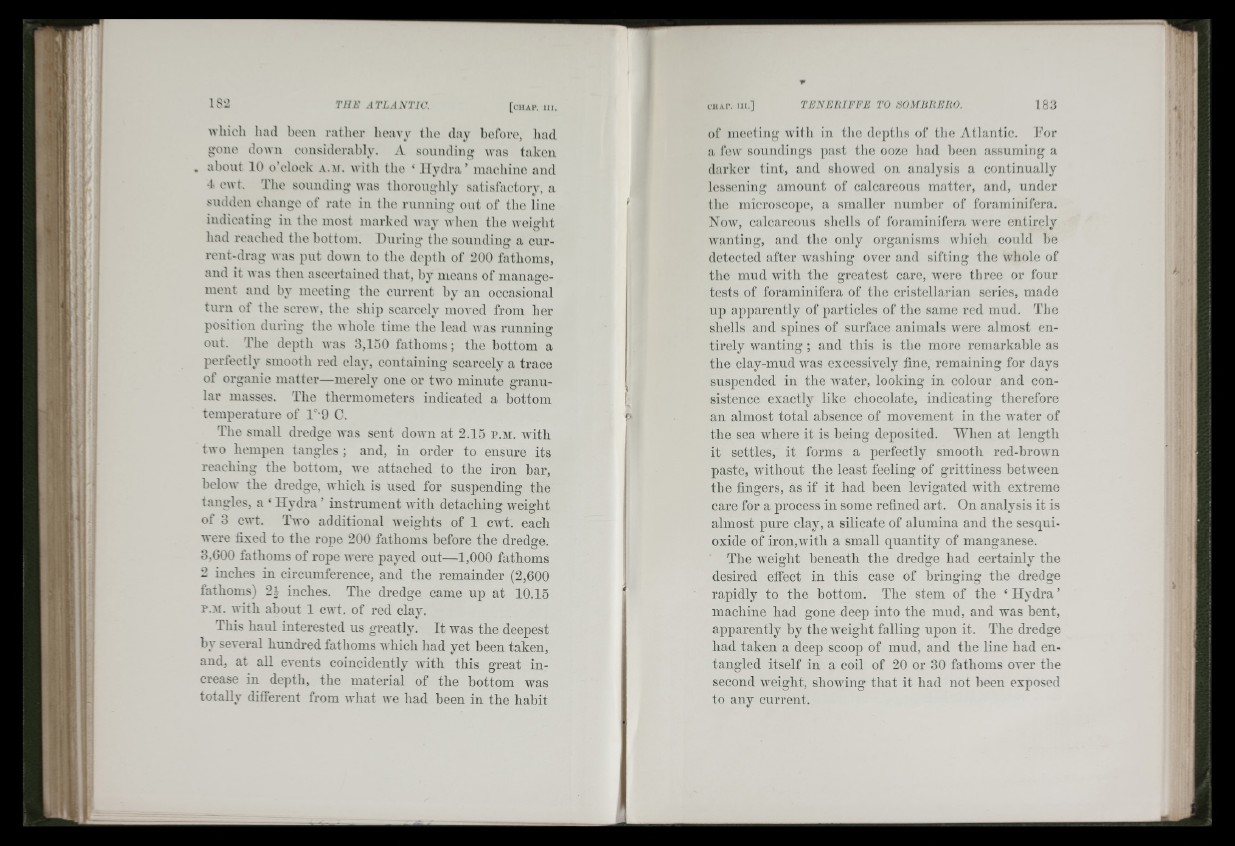
182 Tilt: ATLAM'IC. [ r i i A l ' , u i . CI1A1’. 111. TEN uni P mi TO SOMIllCEIiO. 83
which had been rat her heavy the day hefon', had
gone down eonsidi'rably. A sounding Avas (aluai
. about 10 o clock .a .a i . Avith (he ‘ Hydra.’ maehine and
•I ewt. The sounding Avas thoroughly salislaeiory, a
sudden change ol‘ rate in the running out of the line
iiuiieating in the most marked Avay Avhen the Aveight
had reached the bottom. During the sounding a current
drag Avas put doAvn to the deptli of 200 fathoms,
and it Avas then ascertained that, by means of management
and hy meeting the current hy an occasional
turn of the sevcAv, the ship scarcely moved from her
position during the Avhole time the lead Avas running
out. The depth Avas 3,150 fatlioms; the hottom a
perfectly smooth red clay, containing scarcely a trace
of organic matter—mereh' one or tAvo minute granu-
lar masses. The thermometers indicated a bottom
temperature of 1°'9 C.
The small dredge Avas sent doAvii at 2.15 p.m. Avitli
tAvo hempen tangles ; aud, iu order to ensure its
reaching the hottom, Ave attached to the iron bar,
heloAv the dredge, Avhich is used for suspending the
tangles, a ‘ Hydra ’ iustriimeut Avith detaching Aveight
of 3 cwt. Tavo additional Aveights of 1 cwt. each
Avere fixed to the rope 200 fathoms before the dredge.
3,600 fathoms of rope were payed out—1,000 fathoms
2 inches iu circumfereuce, aud the remainder (2,600
fathoms) 2J inches. The dredge came up at 10.15
p.Ai. with ahout 1 cwt. of red clay.
This haul interested us greatly. It was the deepest
by sereral hundred fathoms w hich had yet been taken,
aud, at all events coiucidently Avith this great increase
iu depth, the material of the bottom was
totally different from Avhat Ave had been in the habit
of meeting wilh in the deptlis of the Atlantic. Por
ii. few soundings [last the ooze had been assuming a
(hirUer lint, and showed on ¡inalysis a eontirrually
h'ssening amount of calcareous matter, and, under
tlie microscope, a smaller number of foraminifera.
Now, calcareous sliells of foraininifera were entirely
wanting, and the only organisms which could he
detected after washing over aud sifting the whole of
the mud Avith the greatest care, were three or four
tests of foramiuifera of the cristellarian scries, made
up apparently of particles of the same red mud. The
shells and spines of surface animals were almost entirely
Avanting ; and this is the more remarkable as
the elay-mud Avas excessively fine, remaining for days
suspended in the Avater, looking iu colour aud consistence
exactly like chocolate, indicating therefore
an almost total absence of movement in the AA'ater of
the sea Avhere it is heing deposited. When at length
it settles, it forms a perfectly smooth red-hroAvu
paste, without the least feeling of grittiness between
the fingers, as if it had been levigated Avith extreme
care for a process in some refined art. Ou analysis it is
almost pure clay, a silicate of alumina and the sesqui-
oxide of iroUjAvith a small quantity of manganese.
The weight beneath the dredge had certaiulv the O O
desired effect iu this case of bringing the dredge
rapidly to the hottom. The stem of the ‘ Hydra ’
machine had gone deep iuto the mud, aud was bent,
apparently by thcAA'cight falling upon it. The dredge
had taken a deep scoop of mud, and the line had eutaugled
itself iu a coil of 20 or 30 fathoms over the
second Aveight, showing that it had not been exposed
to any current.